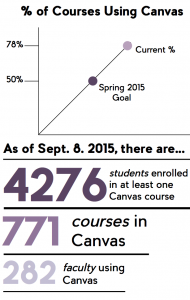 When Dr. Marisa Beard began working at ACU last June, she was shocked that the current learning technology environment created so much confusion for faculty and students.
When Dr. Marisa Beard began working at ACU last June, she was shocked that the current learning technology environment created so much confusion for faculty and students.
“OpenClass was being used, the free version of Canvas, the free version of Blackboard, Moodle and then even WordPress,” said Dr. Marisa Beard, director of instructional technology. “You could have to access your files from six different places. The comment I’ve gotten from students this semester is they are thrilled that there’s fewer places.”
Canvas is now the university’s chief learning management system, after pilots in the fall and spring semesters of last year. Faculty have widely embraced and adopted Canvas, and students have welcomed the new system as well, Beard said. The selection of Canvas as ACU’s official learning management system was the product of a rigorous research and survey process spearheaded by an instructional design team led by Berlin Fang, director of instructional design, and a faculty committee organized by the Adams Center.
“OpenClass is a platform that is still in development,” said Berlin Fang. “So there are lots of functions and features that faculty desire but are not present. The faculty really wanted a more stable platform.”
Fang’s instructional design team conducted in-depth research on different learning management systems and researched which features were desired most by faculty. The team created several surveys to learn what the faculty wanted and then demoed several different learning systems with faculty. Fang’s research showed five main criteria for a new LMS. Those were:
- the ability to post content
- a grade management function
- robust quiz features
- in-depth student statistics and
- plagiarism detection.
These criteria, the research process and faculty testing resulted in the faculty committee selecting Canvas as the university’s new learning management system.
“Canvas was developed by teachers for teachers,” Beard said. “Not that business people can’t develop things for teachers, but when teachers develop something for teachers then they know what’s important. And I think that is evident in the ease of use of Canvas. It’s not only intuitive for faculty, but it’s also intuitive for students.”
Cliff Barbarick, assistant professor of Bible, missions and ministry, participated in the spring pilot of Canvas, utilizing it for his BIBL 102 class.
“It’s a very stable platform,” Barbarick said. “With OpenClass, it seemed like there were regular interruptions when we could not access the tool online. That has not happened so far with Canvas. Also, it seems very intuitive for students to use.”
As many students and faculty may remember, previous learning management systems regularly crashed or were taken offline. However, Canvas is a cloud-based system, Fang said.
“One good thing about Canvas is that it is cloud-based, so that when there are changes, the changes are implemented incrementally in the background, without us having to schedule some kind of downtime to upgrade.”
Beard called the spring pilot a success and said half of the student body enrolled in Canvas by the end of the semester. Fang’s team wants to continue to build on that success through the fall and is now tasked with helping faculty and students migrate from other systems to Canvas. The migration and training is a substantial undertaking, Fang said.
The Adams Center has already taken steps to train faculty and students. Fang’s team designed a self-directed Canvas course to teach faculty many of its features. Other steps include one-on-one sessions with faculty, day-long Canvas intensives, in-class demonstrations and an online Canvas support system.
“ACU purchased a 24/7 support for faculty and staff, so that if people are stuck using the system they can just call them at any time or chat with them,” Fang said.
Barbarick expressed some frustrations with the system, including a lack of design flexibility, but he also was pleased with the university commitment to an LMS.
“We’ve committed for five years, which means I won’t have to recreate my course materials every year when we change to a new LMS,” Barbarick said. “This makes it much easier for me to invest my time in developing tools to use in Canvas. It’s been a helpful tool, and I expect to learn more about it each semester. As that happens, it will become an even more important teaching tool.”

